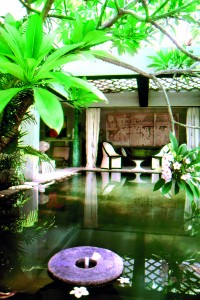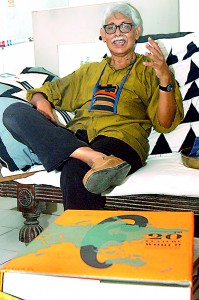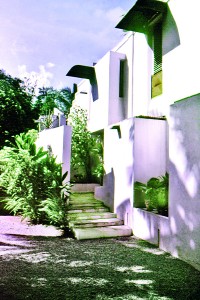A house built for fun stands tall
View(s):Surprised to have been included in the prestigious Phaidon Atlas of ‘20th Century World Architecture’, for one of his well-known early creations, the Lagoon House, Anura Ratnavibhushana, one of Sri Lanka’s foremost architects talks to Renuka Sadanandan of his Bawa years and belief in a simple lifestyle close to nature
In between the numerous houses he has built for clients in Sri Lanka, Anura Ratnavibhushana built three houses for himself. “For fun,” he says, in all seriousness. We meet him in the second of these, in his compact office space in Borella that reflects modernity in all aspects- masterly use of space and design elements visible at every glance, like the talipot palm leaf lamp shade on one wall. But we are here to talk mostly of his first house, built in the early ‘80s which has now made its way into an international architectural digest, one of just three entries from Sri Lanka among some 80 countries represented.

In sunshine and shadow: The mirror-like pool in Lagoon House
The Phaidon Atlas- ‘20th Century World Architecture’released late last year is a hefty and prestigious publication, presenting “an overview of the finest built architecture from around the world completed between 1900 and 1999. The unprecedented global scope of this collection of over 750 key buildings juxtaposes architectural icons with regional masterpieces”, the description reads. Ratnavibhushana’s entry stands with those from the country’s most legendary architects: Geoffrey Bawa- the farm school for the Good Shepherd nuns at Hanwella (the Yahapath Endera-1966) and Minette de Silva- the Kandy Karunaratne house built in 1951.
Ratnavibhushana himself is slightly taken aback that he is in such august company but then he is one of the country’s leading contemporary names with a body of work that is quite remarkably inspirational. His landmark buildings are all over the city and country, the Mahaweli Museum and Royal Asiatic Society library, the UNP headquarters, Kotte, the S.W.R.D. Bandaranaike Museum at the BMICH, the CEB circuit bungalow in Samanalaweva, the Jetwing Ayurveda Pavilions Hotel, Negombo… far too many to list. Last year the Sri Lanka Institute of Architects honoured him with their Presidential Award for his contribution to architecture in this country.
The Phaidon inclusion, is noteworthy yet the house has been recognised even before. The Lagoon House, Moratuwa, as it is known was featured in the book World Architecture, in Mimar (an architecture journal) of December 1987 and in Casa Vogue which gave it a spread under the title ‘Dialogue between history and nature’ in August 1994.
It is a house that holds a good many significant memories for him..his first family house, where he was the client, he laughs. The site generated a sense of fun and energy, 52 perches by the Lunawa lagoon. The approach was through 26 shanty homes and he was careful that it should not stick out but rather dovetail with the surroundings. From the lagoon side, people could walk in, there was no fence along the water boundary. But therein was a contradiction…for it became a fortress at night, when shut, the lagoon views visible only from roof tops and a few fixed glass windows.The rest was solid masonry. It was a courtyard house with a mirror-like pool at the heart of it, ‘like a large emerald gemstone within a coarse granite border”, part of it, open to the sky. The immediate garden was wild –filled with mangroves and boulders, where kabaragoyas and ratsnakes would come calling. The large shuttered windows had magical views of the garden with its huge boulders, the lagoon and even the ocean.

Among the greats: Anura Ratnavibhushana with the Phaidon Atlas ‘20th Century World Architecture’. Pic by Nilan Maligaspe
He likens it to a jewel box which you open and look and close…the jewel being the outside. Great simplicity, great tranquility.
Thankfully he says his wife Sundarika gave him the freedom to create as his fancy took him. “My wife knew it was my childlike fantasy and I wanted to explore every idea I had been trained in and gifted with…that sense of fun!
Lots of lovely people came to that house, he remembers. Geoffrey Bawa and Ulrik Plesner, the architectural giants he regards as his mentors– they opened a bottle of champagne to celebrate it. Students would come too, it was a pilgrimage of sorts. But when practical considerations of travel time to Colombo weighed in with his young son’s schooling, he had no qualms about moving on, though he recalls Bawa telling him that the house would be difficult to sell. It was… it took him all of three years to find a buyer.
Anura Ratnavibhushana trained as an architect in the Institute of Practical Technology, Katubedde (now the University of Moratuwa) where he first encountered Bawa, Plesner and Justin Samarasekera (with whom he also briefly worked) then won a 26-month scholarship to the Royal Academy of Fine Arts in Copenhagen, Denmark to do his post-graduate studies. From his second year at architectural school he was invited by Bawa to work part-time with him and by the time he was in his third year, he was a regular at Edwards, Reid and Begg, Bawa’s office, a close and fruitful association that would continue for 12 years, even when he returned from Denmark.
The connection with Bawa he still cherishes. That Bawa held him in high regard and entrusted him with many significant commissions is evident. One dedication in a book of Bali murals Bawa gifted him reads, “To Anura…with many years of admiration”. Yet he is reluctant to talk of what was a very personal relationship in his early years. “I have no authority to talk about him, though I knew him like my father. I was the first architectural student he took over from the school and worked for 12 years directly as his assistant. It was a period of great learning.”
It was the golden era of modernity in Sri Lanka with Bawa and Plesner from whom he, Ismeth Rahim and others directly learnt the methodology of doing things, he reflects. “The poetry was Geoffrey, the inspiration came from Geoffrey. Plesner had both but he also taught us how to get about doing things, the functional aspects, like the dimensions of chairs, tables, doors, toilets, all needed practically. Their genius was anchored by the engineering skills of Dr. K. Poologasundram, a partner in the firm whom he remembers with admiration as the ‘ultimate’ architect’s engineer.

Simple lines: The entrance to the Lagoon house
It was too a renaissance age when they had the privilege of working with great artistic minds like Barbra Sansoni, Ena de Silva, Laki Senanayake, so buildings were adorned, enhanced by art.
Years later Bawa would curate an exhibition ‘Objects that Enhance Architecture’ as his own maiden venture for the Bawa Trust in 1992 bringing together some of these legendary names to which Ratnavibushana too was invited to contribute, though he himself lays no claim to being an artist. His was an installation of motor vehicle parts ‘ Crank-shafts in blue and green’.
“Geoffrey never taught.He would give a whole idea in two words and it would be profound and funny,” he says, describing him as instinctive and intuitive above all. He recalls an incident during the Expo ’70 Ceylon pavilion in Osaka, Japan where ER&B did the concept in Colombo and it was built by Mitsui in Japan. “Huge modern glass boxes, they made. We described serenity through a Vesak sort of mood of light..pure white. The only objects were gems, temple murals and ancient Polonnaruwa statues. The wall mural was from a Buddhist temple in the south, it was photographed here and Geoffrey took the slides and gave it to the Japanese to blow up.” He smiles as he recalls Bawa’s description of how the next morning he was confronted with three bowing gentleman who had a problem: all the pictures were out of focus. Bawa’s answer was typical of his laconic wit: Everything in Ceylon is out of focus, he told them.
After the Bawa years, Ratnavibushana went overseas to work briefly in Nigeria and on his return joined Design Group 5, to work part-timewith architects of the calibre of Gemunu Fernando, Suranjith de Silva Ashley de Vos, Tudor Sirisena, Suren Wickramasinghe and Tanya Wickramasinghe. In the 80’s and 90’s he was with Mihindu Keerthiratne Associates before launching on his own in 1997.
At 72 now, he still has sheer enjoyment in his work. His autobiography, ‘Creating Simplicity’ released in 2009 sought to present many of the concepts, influences and inspiration he has pondered onand distilled over the years and which he takes delight in sharing with others, his young architectural students eager beneficiaries of his mercurial mind. It was with them that he tried the ‘experiment’ in his garden, of building with glass, wanting to see how the modern ‘bake-houses’ as he called it would work. Visually smart, yes, he agrees but he grappled with the inherentissues of maintaining privacy, the immense heat and technology problems. They were solved but at a cost, which leads him back to what he believes is an answer to many of our current woes- simple living.
Technically you can fix anything but sustainability cannot be fixed by technology alone. We have to change our lifestyles. We have to become frugal. You look at all our religions……they are basically frugal. The old churches, Buddhist temples, they are first and foremost for God, for enlightenment and simplicity. This ‘me, me, me’ concept is a philosophy alien to this society, he says emphatically urging a rediscovery of great thinkers like Ananda Coomaraswamy, our greatest exponent of the East to the West. It’s not the ego of the individual creator that is important, it is the necessity of society with religion, society and family. Now we are teaching our children ‘me me me’ and that is inconsistent with sustainability, he says.
“Despite our emphasis on ‘bio this and bio that’ if we continue to live the same way, we will continuously pollute. We have to become more simple. We have enough food, water, we have four major religions..all of whom propound austerity. If we don’t grasp this, if we think we can techno-fix our lives out of this, by pretending we can live the same way…it’s an endless disaster.”
“I have come to a stage in my life, when I see a rock, I see the gorgeous beauty nature has given us. But we must not consume everything at the expense of our children,” he says.
His own house in the heart of the city is well shrouded in green and a great proponent of using the natural environment in design, he is delighted with Colombo’s current transformation into a greener city. “Some places are magical…take a walk along Independence Square,” he urges, saying the happiness of people is visible. He talks of Rob Krier, a visionary city planner who wanted a city to be planned in such a way that you, your family your friends and others can take joy in using it.
Colombo’s greening, he hopes is being done without wastage, stressing the need to recycle, reuse and reduce. The planners, architects, engineers and visionaries all have to have a sense of ethics and conscience and make sure they don’t abuse materials like rocks, cement and concrete. Use more green things to mitigate it…Or what are our children and grandchildren going to be left with, he asks.
His own childhood was, as he says in his book, as interesting as any child could wish for. His engineer father and mother took their nine children travelling all through the ancient cities and hill country, instilling at a very early stage the appreciation for nature, ancient places and books, all of which have stayed with him. He schooled mainly at Kingswood, Kandy and for a spell at Hindu College, Trincomalee for a couple of years where he remembers the outdoors with appreciation “we sat and learnt under a tree” and wonders why today’s parents scarcely set any store by such simple pleasures. Children today are ‘lovingly harassed’ as he terms it by their parents into an endless round of activities which leaves them no time to wonder and dream.
An austere simplicity in lifestyle, sensitivity to the environment, these are what Anura Ratnavibushana with all his wealth of experience believes we must return to. The Lagoon House, Phaidon’s pick, reflected these principles, some 30 years ago.
20th Century World Architecture is available at M.D. Gunasena’s.
Follow @timesonlinelk
comments powered by Disqus



















